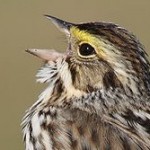
The last time I wrote about the evolution of language, scientists’ theories sounded like contradictory Just-So stories. Some said language began with gestures, like pointing at the food you want. Others said language began with talking, like “look out!” or “hey you, get over here.” Nobody had much solid evidence: language evolved, after all, without leaving fossils. Now, 25 years later, they’re still arguing, but a nice article by Michael Balter in a recent Science says they’re doing it with real data. And so far it looks like evolution didn’t choose between talking and gesturing, it did both. Evolution doesn’t have to choose, it can do whatever it feels like.

One way to study the evolution of language is to study the primates from which we evolved. Primates are great gesturers – remember Washoe the chimp and American Sign Language? — and the gestures have specific meanings: “go away,” “come play,” “gimme that.” Primates also talk, or as human-primate scientists say, “vocalize.” Their vocalizations are also specific: one call means snakes, another means leopards; one call means scary attacks, another means not-scary attacks, or food and really good food. One set of primates goes further and arranges these calls – “Krak,” “Hok-oo”, “Boom” – into complicated sequences that a less-scientific mind might think of as sentences. When you hear them, they sound like aliens singing.
More evidence: talking and gesturing seem to be neurologically related. In all primates, humans included, language and gestures are in same half of the brain. One specific part of the brain in humans controls talking; a similar part in primates controls gesture. One specific part of the brain in primates controls “vocalization;” the similar part in humans controls understanding speech. In short, evolution as usual is uninterested in simple solutions and does whatever works.

One big difference between human and non-human primates is vocal learning, that is, the young learn to talk by imitating the sounds their elders make. The only creatures as good at this as humans — non-human primates don’t do it — are birds. Baby birds don’t sing unless they’ve heard the grownups sing, and in the early stages of learning to sing, they babble, or as non-avian scientists call it, “subsong.” And the areas in birds’ brains responsible for both singing and learning to sing are the same areas that in primates, human and non-human, are devoted to talking, vocalizing, understanding, and gesturing. Sadly, the scientists do not go on to overthrow dogma and say we’re descended from birds.
Nor do they say that the common ancestor of primates and birds – whatever 300 million-year-old creeping amniote that was — must have been a singer: Balter says, “that was just too long ago.” Rather, they think that a brain that learns to sing and talk can be built only a few ways, as Balter says, and evolution just used the same trick at different times on different species. Evolution, we all know, is a tricky character.
Source for article which, sorry, is behind a subscription wall: Science, 5/21/10, p. 969.
Sources for photos: Wikimedia Creative Commons; orangutan by Malene Thyssen; sparrow by Cephas.
very interesting! So there may be scientific support for my being occasionslly called a bird brain…
Question – do nonverbal cues like body language fall into the gestures catagory or is this considered a pseudoscience?
That question is smart and interesting and I don’t know the answer. So I’ll make one up: I’ll guess nonverbal cues — which might be iffy science but probably wouldn’t be pseudoscience — aren’t intentional enough to be called gesture. I’ll repeat, I made that up.